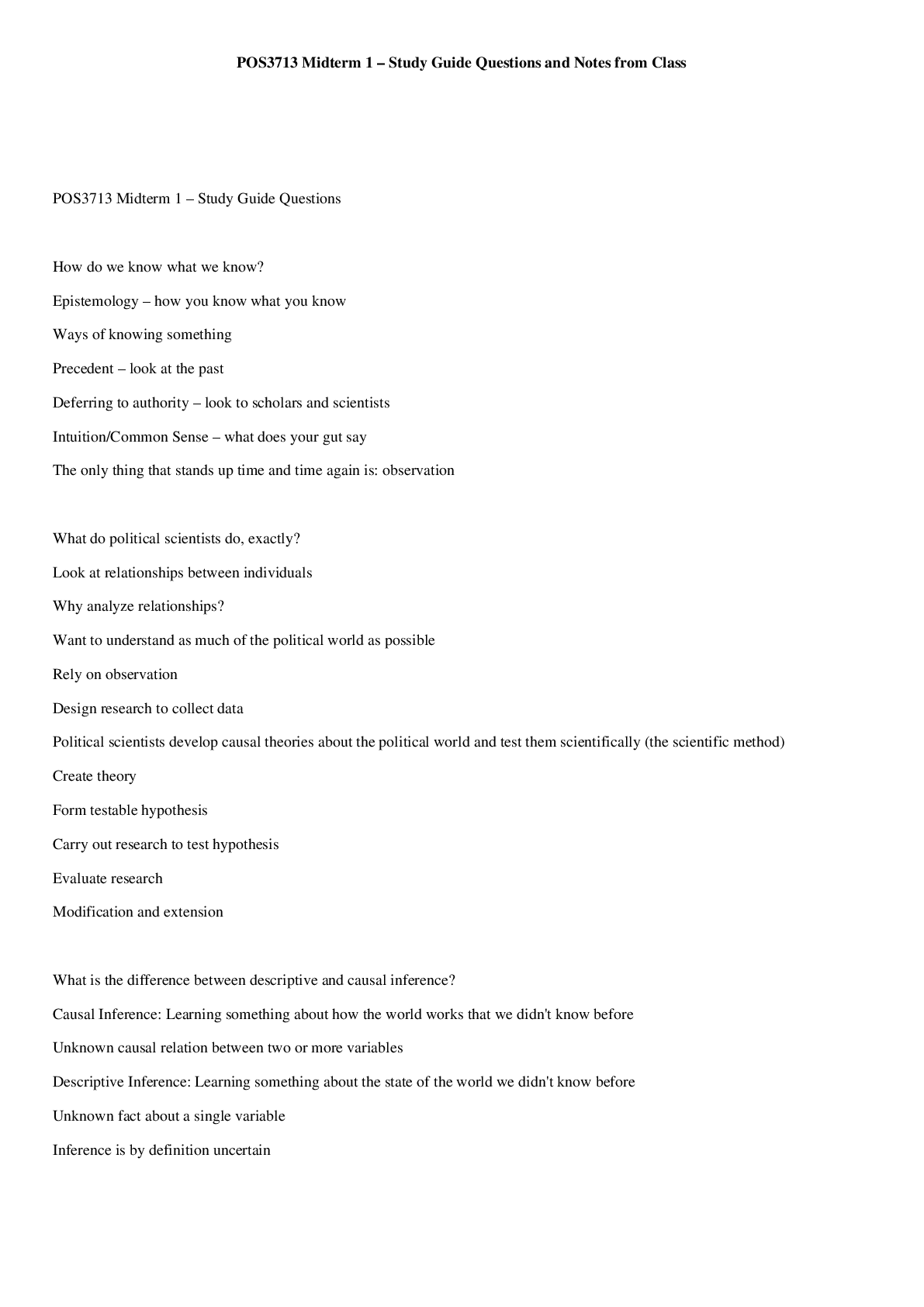*NURSING > STUDY GUIDE > NBHWC Exam Prep (GRADED A) Study Guide Questions and Answers. (All)
NBHWC Exam Prep (GRADED A) Study Guide Questions and Answers.
Document Content and Description Below
Locke + Latham Theory: why goals lead to behavior change DEPAD Directive, Energizing, Persistence, Arousal + Discovery 3 Key Risk factors for heart disease high BP, high cholesterol, smoking (h... alf of all Americans have at least one) What is the "silent killer?" high blood pressure (hypertension) Adults who have what have a higher risk of death from heart disease? Diabetes 5 D's of Appreciative Inquiry Define Discover Dream Design Destiny 6 diseases/conditions associated with chronic inflammation CAD, diabetes, obesity, arthritis, cancer, alzheimer's Social-Cognitive Theory: human behavior is determined by 3 factors personal, environmental, behavioral Self-Determination Theory: 3 primary psychological needs Autonomy, competence, relatedness Smoking can cause what almost anywhere in the body? cancer Smokers are 12-13x more likely to die of what disease than non-smokers? COPD In the US, 7 of 10 smokers want to what? quit Americans are addicted to what more than any other drug? nicotine People with metabolic syndrome often also have what? (2) blood clotting and low grade inflammation 3 key risk factors for heart disease smoking, high cholesterol, high BP What is the most common form of arthritis and how many people suffer? osteoarthritis, over 30 million heart-healthy changes for people with metabolic syndrome (5) Heart healthy eating, aim for healthy weight, manage stress, physical activity, quit smoking Largest preventable cause of death and disease in the US is what? Tobacco use Social Determinants of Health include (3) exposure to crime, quality of education, socio-economic conditions Mental Health is comprised of 3 kinds of well-being social, psychologial, emotional 5 tips for better sleep hygiene 1. be consistent 2. bedroom quiet, dark, comfortable 3. remove electronic devices 4. avoid eating drinking 5. exercise Sleep is necessary for proper functioning (3) immune, endocrine, neurological Adequate sleep is necessary to support what metabolism of sugar short sleeper = less than 6 hrs/night sleep-disordered breathing can lead to a 2-3 fold risk of stroke + mortality Insufficient sleep is linked to 4 chronic diseases depression, diabetes, obesity, cardiovascular disease Holding oneself back with self-defeating behavior and repeatedly processing feelings versus moving on require what mental health referral 3 most common drugs involved in overdose methadone, hydrocodone, oxycodone side effects of opioids include sleepiness, sweating, constipation another class of prescription drugs involved in opioid deaths (ex. xanax) benzodiazepines Primary driver of endocrine stress response HPA axis What can affect how quickly food moves through the body? Stress It is responsible for fight or flight Sympathetic Nervous System (SNS) It facilitates recovery from SNS response Parasympathetic Nervous System response (PNS) Risk for what 2 conditions goes up when waist-to-hip ratio exceeds .95 for men and .85 for women heart attack + stroke 3 important aspects of stress management sleep, exercise, social support all cause death, hypertension, CAD, stroke, T2D, gallbladder disease, osteoarthritis, sleep apnea, some cancers, low quality of life, mental illness, body pain are consequences of what? obesity Percentage of people unaware they have a substance abuse issue 95% 3 facets of life impacted by substance abuse child abuse, teen pregnancy, crime 2 things that can reduce alcohol consumption brief counseling, alcohol screening Drinking too much can lead to these 3 conditions heart disease, STDs, breast cancer How many controllable risk factors for T1D 0 Pain, stiff all over body, fatigue, depression, anxiety, sleep problems, problems with thinking, memory and concentration symptoms of fibromyalgia pain/aches, stiffness, decreased range of motion, swelling symptoms of osteoarthritis Pain/aches in more than one joint, stiffness in more than one joint, tenderness and swelling in more than one joint, same symptom on both sides of the body, weight loss, fever, fatigue, weakness symptoms of rheumatoid arthritis exercise, diet, obesity, alcohol, tobacco, pre-hypertension, gestational diabetes, prediabetes, baby over 9lbs controllable risk factors for hypertension history of OA in another part of the body, genetics, age, women more than men, race (some Asians have lower risk) uncontrollable risk factors for osteoarthritis what is the one controllable risk factor for osteoarthritis obesity age, women more than men, no live births, early exposure to secondhand smoke uncontrollable risk factors for rheumatoid arthritis previous gestational diabetes, previous baby 9lbs, PCOS controllable risk factors for gestational diabetes obesity and tobacco use controllable risk factors for rheumatoid arthritis family history of T2D, 25years +, race (minorities) uncontrollable risk factors for gestational diabetes exercise, overweight, prediabetes, gestational diabetes, baby over 9lbs controllable risk factors for T2D overweight, obesity, tobacco use controllable risk factors for osteoarthritis family history, genetics, age, women more than men, joint injury/overuse, infections, occupation/repetition, stressful/traumatic events uncontrollable risk factors for osteoarthritis parent/sibling with it, 45yrs+, race (minorities) uncontrollable risk factors for T2D family history, genetics, age, familia hypercholesterolemia, gender (up to 55 women have lower LDL, all ages men have lower HDL) uncontrollable risk factors for lipid abnormalities This condition has no controllable risk factors and only one uncontrollable risk factor which is fibromyalgia; age family history, genetics, women and men about the same, age, black people more that white people and develop this earlier in life uncontrollable risk factors for hypertension parent/sibling with T2D, 45yrs+, race (minorities) uncontrollable risk factors for prediabetes exercise, diet, overweight, gestational diabetes, baby over 9lbs controllable risk factors for prediabetes Sudden numbness/weakness in face, arm, or leg (one side); sudden confusion, difficulty speaking, understanding speech; sudden trouble seeing in one or both eyes; sudden trouble walking, dizzy, loss of balance, coordination; sudden severe headache with no known cause symptoms of a stroke chest pain/discomfort; weakness, lightheaded, cold sweat; pain/discomfort in arms/shoulder; shortness of breath; in women nausea symptoms of a heart attack family history, genetics, increased risk with age, #1 killer for african americans, hispanic/latino, american indian, AK natives uncontrollable risk factors for heart disease #1 and #2 killers of asian americans and pacific islanders 1. cancer 2. heart disease parent/sibling with this disease, age (child, teen, YA), race (af-am, latino/hispanic) uncontrollable risk factors for T1D frequent urination at night, thirst, weight loss without trying, very hungry, blurry vision, numb/tingling hands or feet, very tired, dry skin, sores heal slowly, more infections than usual, nausea, vomiting, stomach pains symptoms of T2D exercise, diet, obesity, alcohol, tobacco, hypertension, T2D, dyslipidemia controllable risk factors for heart disease exercise, diet, obesity, alcohol, tobacco, hypertension, T2D controllable risk factors for stroke exercise, diet, obesity, tobacco use controllable risk factors for lipid abnormalities family history, genetics, increased risk with age, women more than men (birth control/pregnancy), sickle cell, race (minorities) uncontrollable risk factors for stroke Black people are at a 2x higher risk for this disease and more likely to die from it stroke inactivity, obesity, prehypertension, high fasting BG level or history of diabets, PCOS, high triglycerides/low HDL, waist circumference, insulin resistance controllable risk factors for metabolic syndrome parents/siblings with diabetes, genetics, age, women more than men, Mexican-Americans have the highest rate (then blacks, then whites), on drugs/meds to treat symptoms, joint injury/overuse uncontrollable risk factors for metabolic syndrome Adults with diabetes, high blood pressure, or both have a higher risk of developing this. Approximately 1 of 3 adults with diabetes and 1 of 5 adults with high blood pressure have this. chronic kidney disease About 60% of people who have diabetes also have high blood pressure 9/10 americans will develop it during their lifetime and compared to whites, blacks develop it earlier in life high blood pressure 7th leading cause of death, 30 million people have it and 1 in 4 don't know, #1 cause of kidney failure diabetes 84.1 million people have this (more than 1 in 3) and 90% don't know they have it. prediabetes in the US whites are more likely to develop this than african americans T1D tobacco use can cause (3) heart disease, cancer, stroke a condition in which a waxy substance called plaque builds up inside the arteries that supply blood to the heart ischemic heart disease Dysmetabolic syndrome, Hypertriglyceridemic waist, Insulin resistance syndrome, Obesity syndrome, Syndrome X are all other name for what metabolic syndrome BMI and waist circumference are not diagnostic tools for disease risks American Diabetes Association suggests what regarding vegetables? Fill half your plate with non-starchy vegetables DASH diet sodium and potassium recommendations 2300mg max, 1500mg for quicker/more significant BP-lowering results, 4700mg potassium per day What does all of these: Keep your temperature normal; Lubricate and cushion joints; Protect your spinal cord and other sensitive tissues; Get rid of wastes through urination, perspiration, and bowel movements Water Adequate _________ is necessary to Fight off infection, Support the metabolism of sugar to prevent diabetes, Perform well in school Work effectively and safely sleep Insufficient ________ and _______ disorders are associated with: Heart disease, High blood pressure, Obesity, Diabetes, All-cause mortality sleep, sleep Social Learning Theory Theory that people learn from one another, via observation, imitation, and modeling. Why in coaching we encourage clients to find role models. Self-Efficacy Theory Self-efficacy can be a predictor of whether a person will succeed at making a change. "Whether you think you can, or you think you can't-you're right." - Henry Ford 3 Ds of Precontemplation Don't know how, Demoralized, Defensive Techniques for Precontemplation Stage Non-judgementally validate not wanting to change, encourage exploration, reinforce personal autonomy Techniques for Contemplation Stage Explore ambivalence, explore best experiences and strengths, ID clear vision Techniques for Preparation Stage Develop strategies to navigate barriers, experiment with possible solutions and approaches, brainstorm Techniques for Action Stage Continue tying strengths and values to stay on track, positively reframe setbacks ("tries" not "failures") Techniques for Maintenance Stage Set new related goal/ challenge, revisit and reconnect to strengths, vision and values, explore lapses/relapses, positively reframe setbacks. Key Points of Contemplation Considering, ambivalence, "I may" within six months Key Points of Preparation strong motivation, "I will," within one month Key Points of Action in process of doing, experimenting, learning, "I am," lasts at least six months Key Points of Maintenance Has been doing for 6+ months, "I still am!" May need new challenge Key points of relapse and termination These WILL happen; part of stages and growth. Explore all sides and learn from it; reframe. Social determinants for health-related issues include: socioeconomic status, transportation, housing, access to services, discrimination by social grouping, social or work-related stressors 5 Key areas/determinants of health Economic Stability Education Social and Community Context Health and Health Care Neighborhood and Built Environment Side effects of prescription opioids Tolerance, Physical dependence, Increased sensitivity to pain, Constipation Nausea, vomiting, and dry mouth, Sleepiness and dizziness, Confusion, Depression, Low levels of testosterone that can result in lower sex drive, energy, and strength, Itching and sweating Common Benzodiazepines Xanax, Valium, Ativan, also called Lorazepam What criteria makes a quality wellness vision? Grounded (building on current success) Bold (stretching the status quo) Desired (what people truly want) Palpable (as if they were already true) Participatory (involving many stakeholders) 3 strategies used in coaching to help strengthen a client's commitment to action [Show More]
Last updated: 8 months ago
Preview 1 out of 18 pages
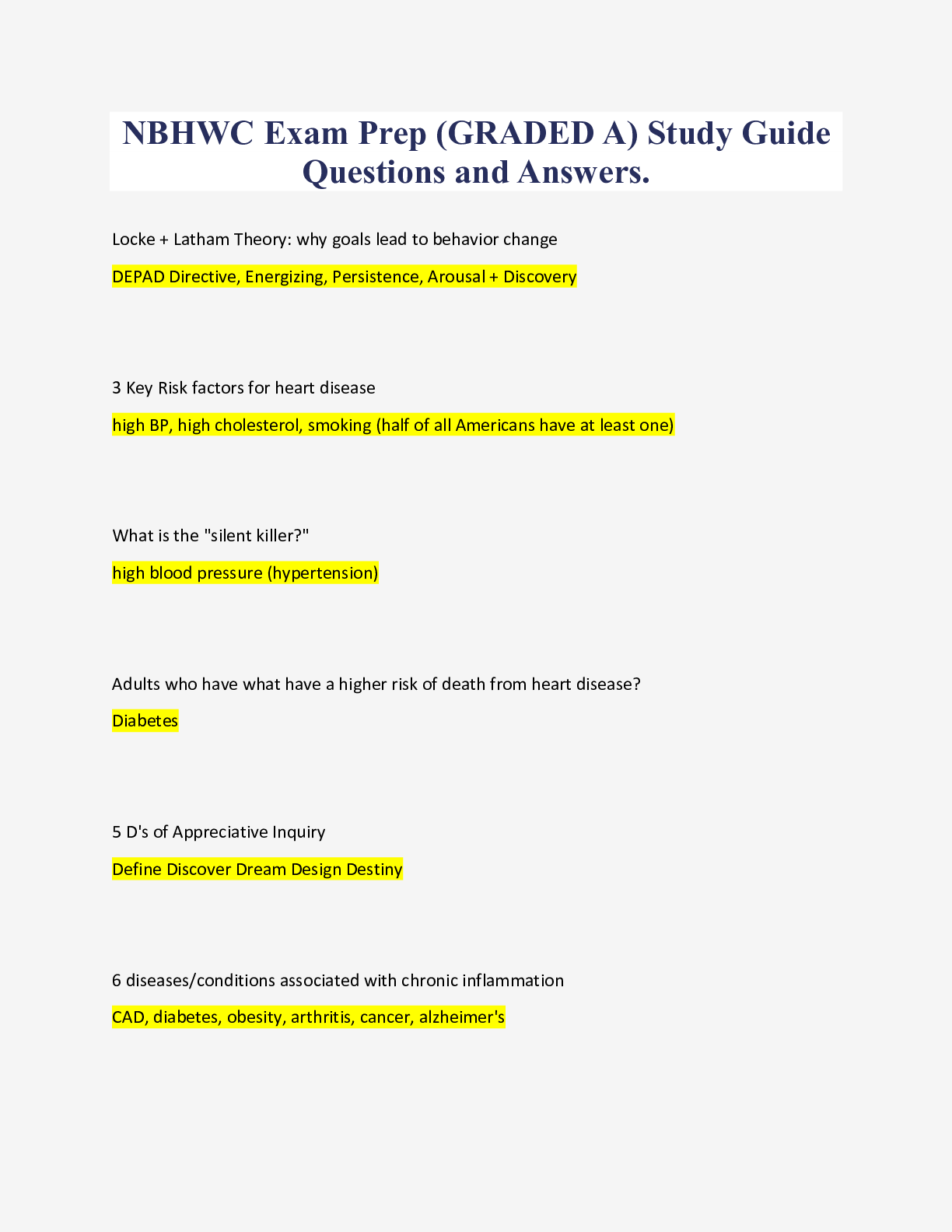
Buy this document to get the full access instantly
Instant Download Access after purchase
Add to cartInstant download
We Accept:

Also available in bundle (1)

NBHWC (National Board for Health & Wellness) Exams and Study Guide PACKAGE DEAL
NBHWC (National Board for Health & Wellness) Exams and Study Guide PACKAGE DEAL
By Goodluck Academia 8 months ago
$20.5
4
Reviews( 0 )
$10.00
Document information
Connected school, study & course
About the document
Uploaded On
Oct 16, 2023
Number of pages
18
Written in
Additional information
This document has been written for:
Uploaded
Oct 16, 2023
Downloads
0
Views
127











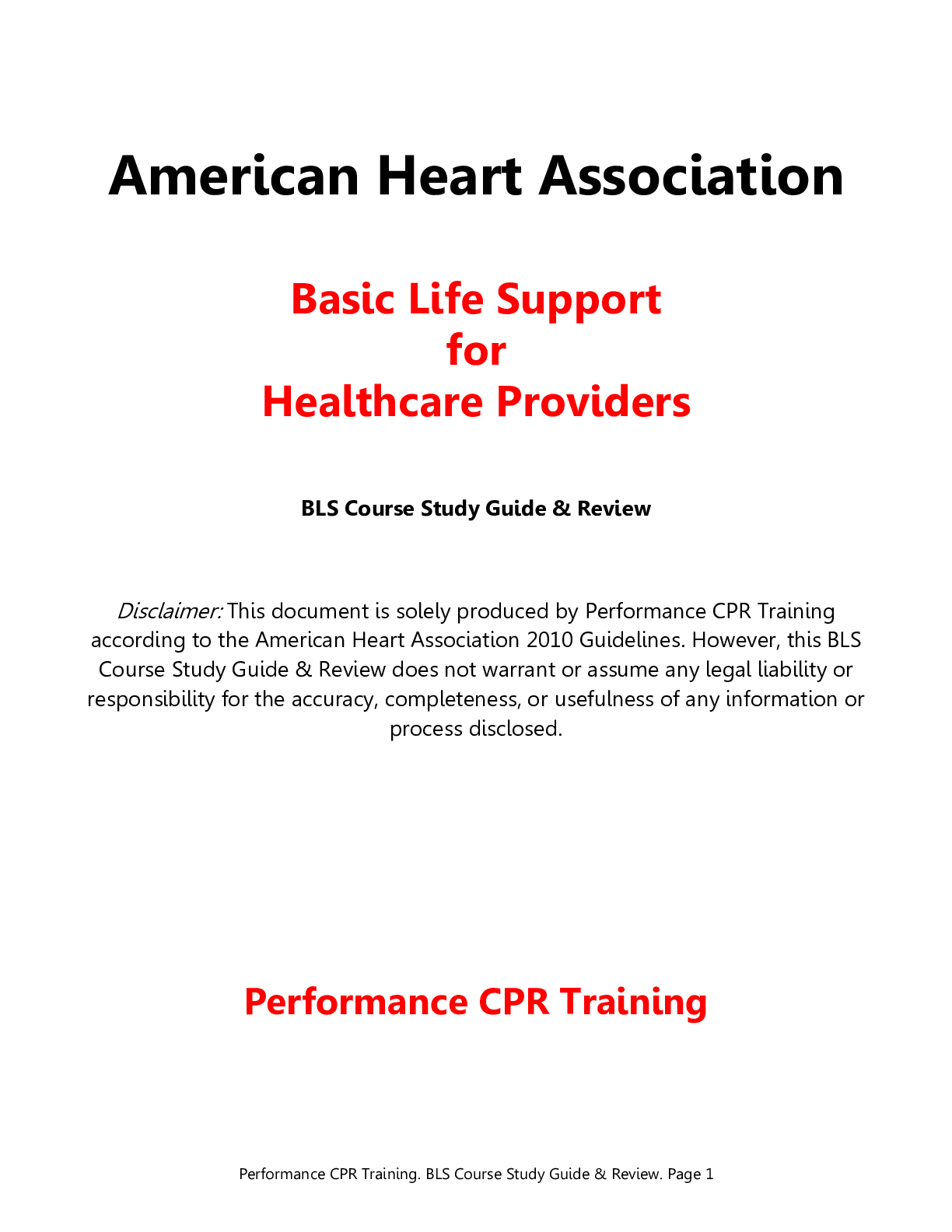
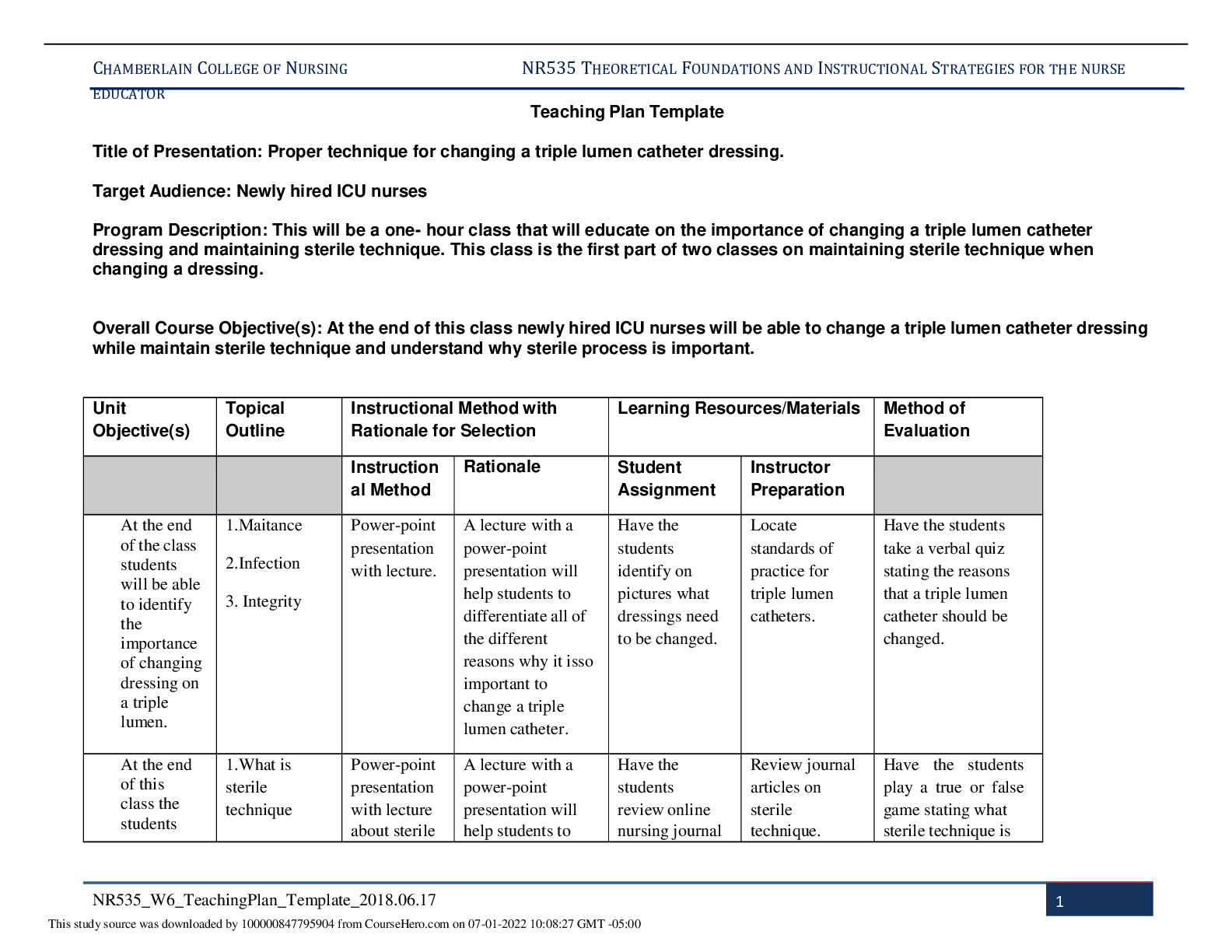
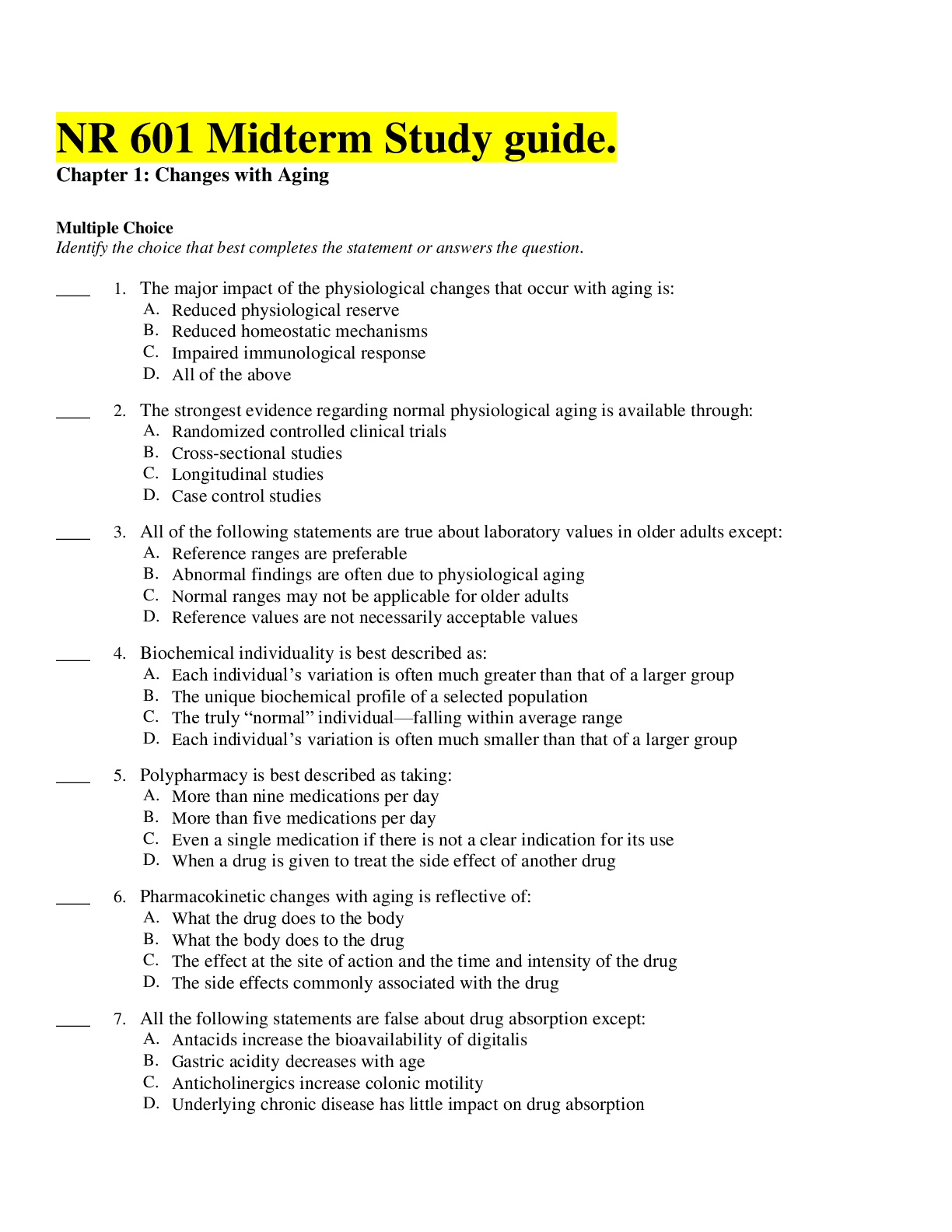
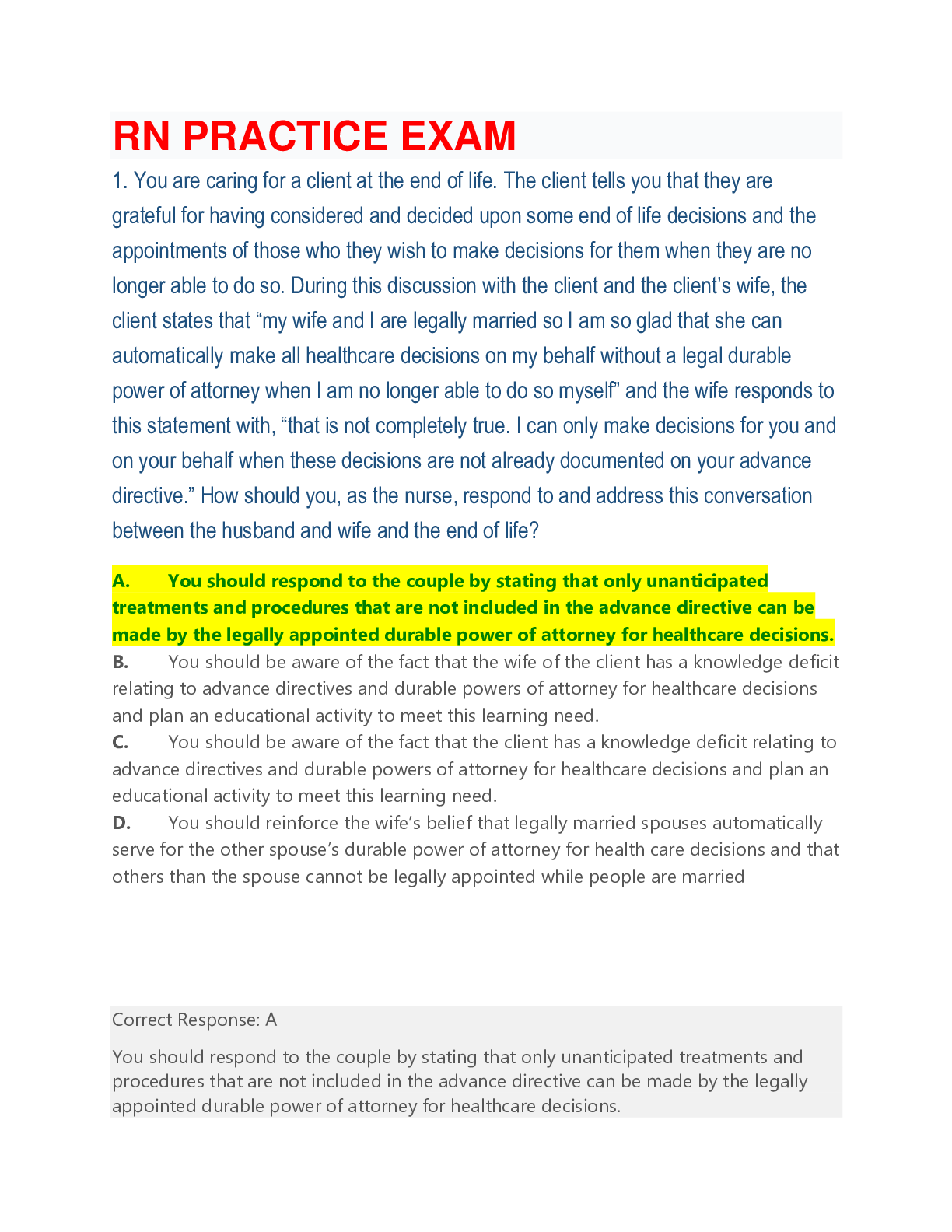


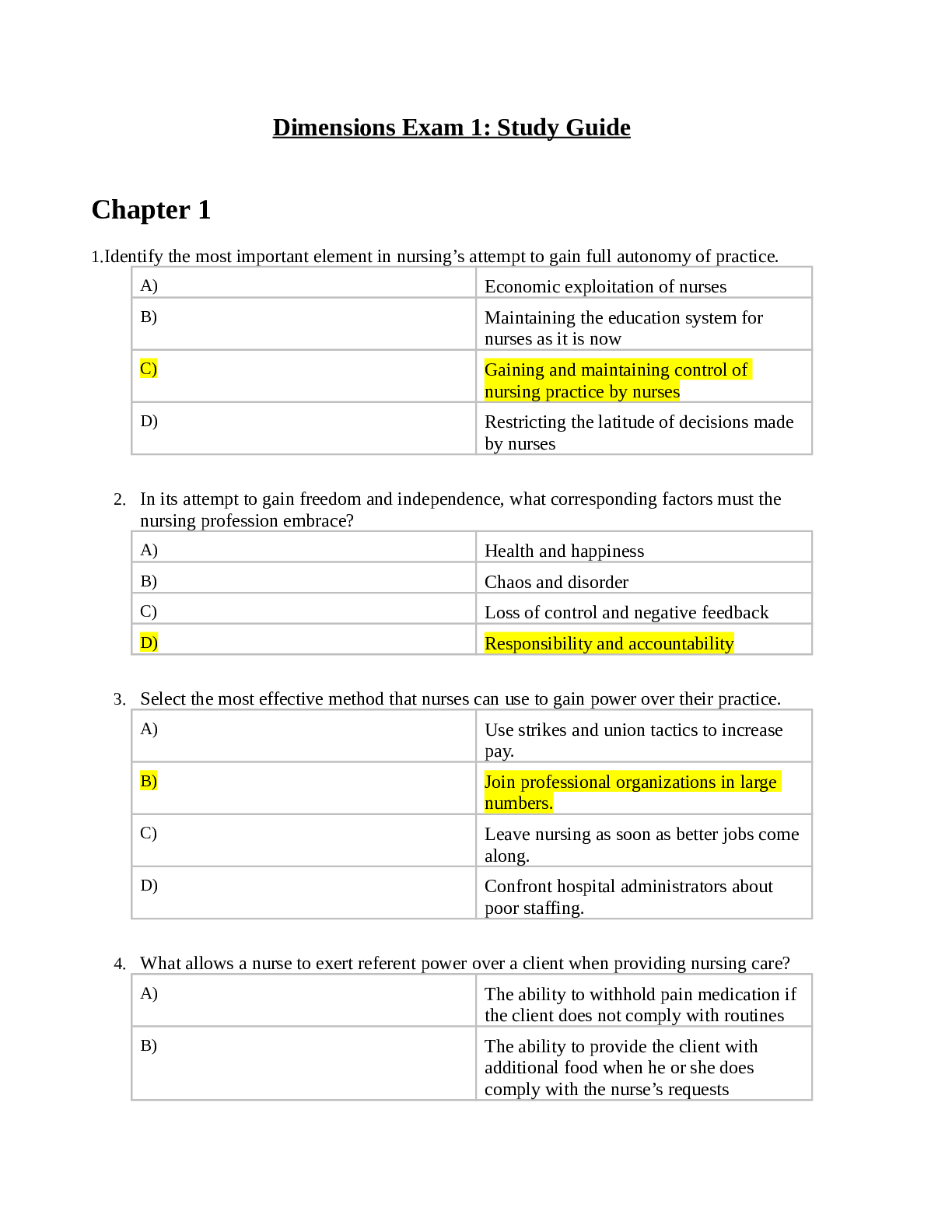


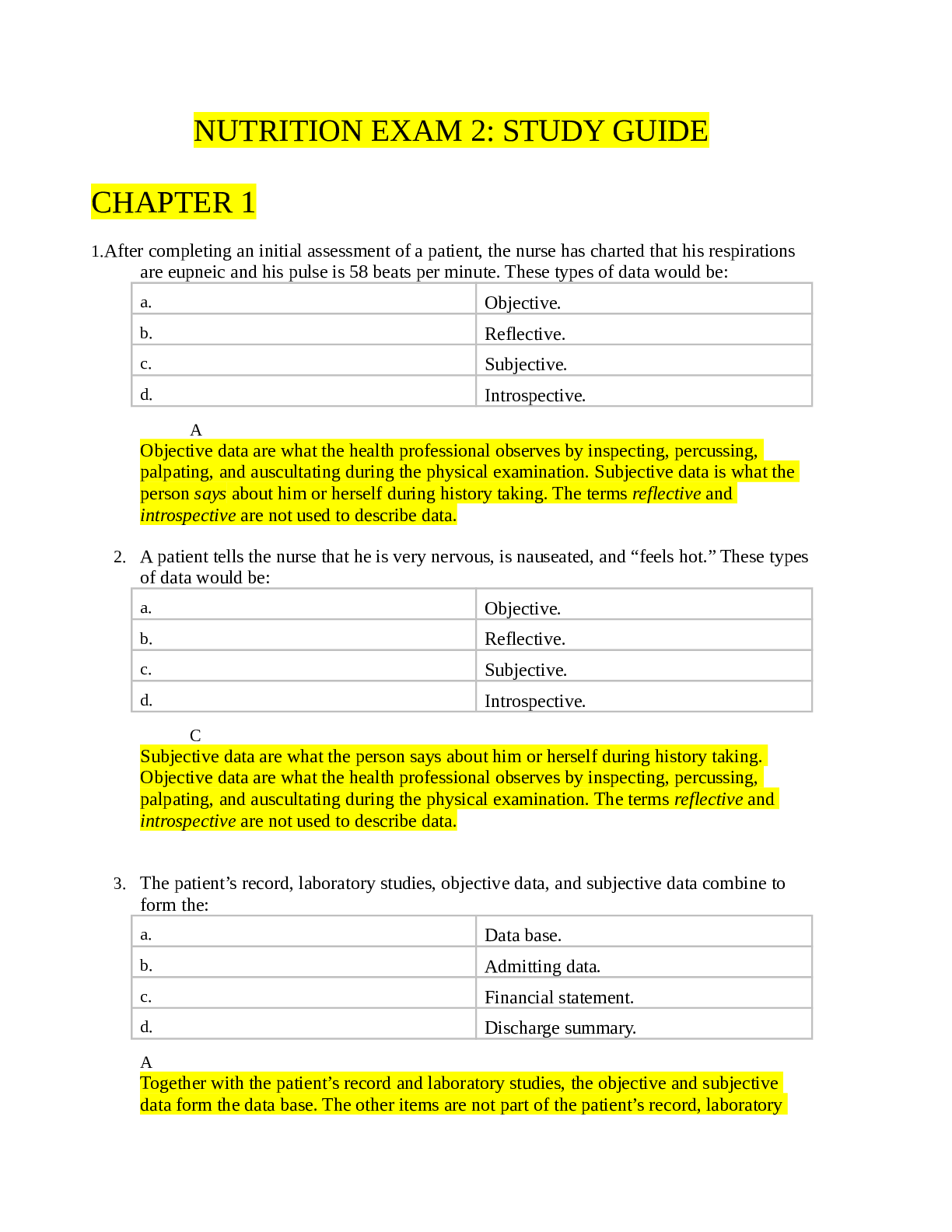
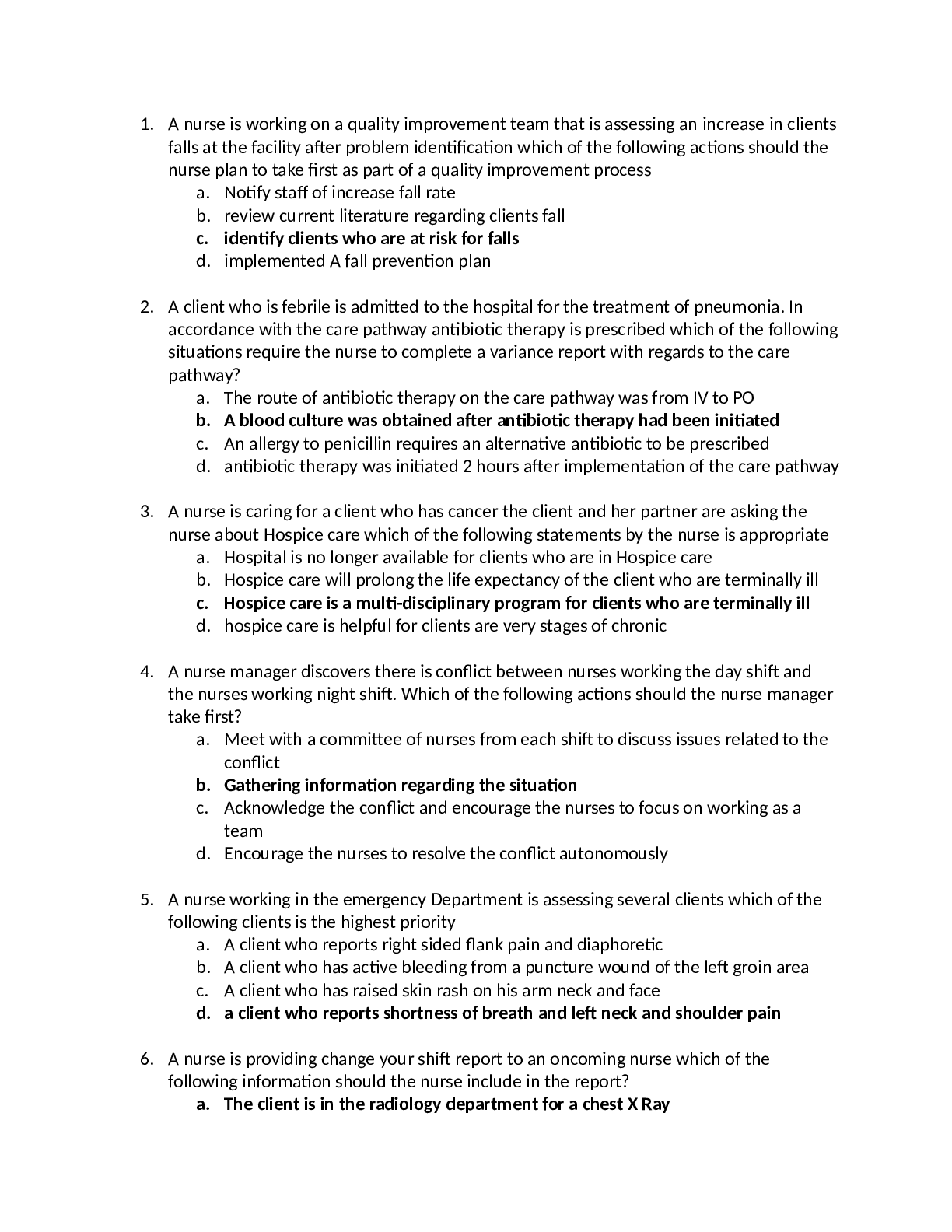
 Primary Care of the Maturing and Aged Family Practicum Midterm Study Guide.png)
